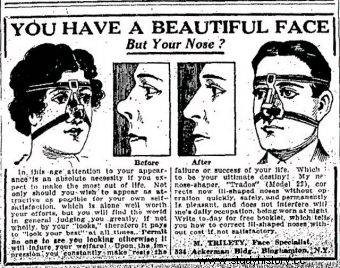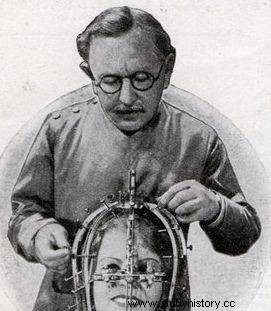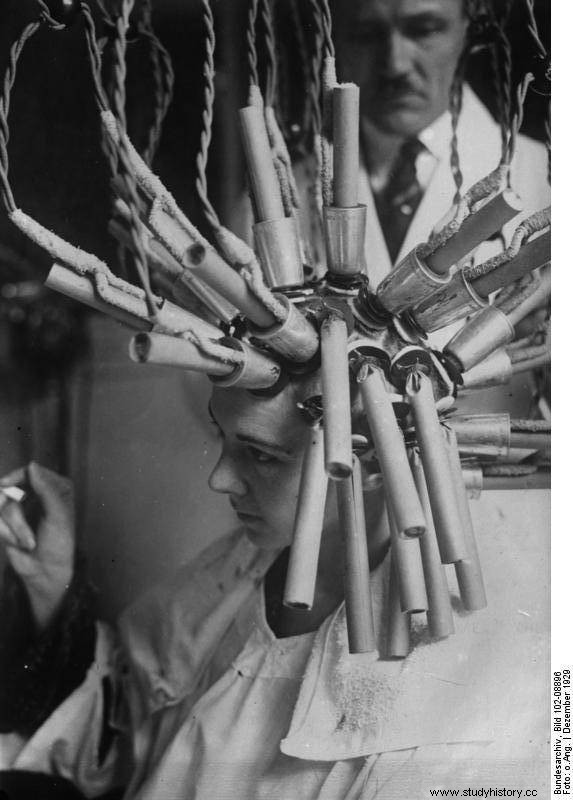A nose straightener, a double chin reducer and a cosmetic smothering machine. The old beauty tools are alive like props from a horror movie.
The ideal of female beauty has changed over the centuries, but one thing has remained the same - the pursuit of perfection. Women have always eagerly used various benefits of nature to brighten their skin, make the cheeks pink and change the color of their hair. The human desire for a perfect appearance inspired the inventors to hard work. The effects of their work were sometimes bizarre. Certain devices our grandmothers used to dry or curl their hair or remove wrinkles look like torture devices.

An upturned nose is not a problem if you have such a "miracle of technology" (source:public domain).
The work of Max Factor, a pioneer in the field of mass production of color cosmetics, deserves the title of the most terrifying invention. The make-up artist and makeup artist created in the early 1930s "beauty calibrator" which was intended to analyze the features and proportions of the face. The device looked like a metal cage studded with nails.

Miracles and wonders of electrics in the service of beauty. Our great-greats and great-grandmothers were delighted with this. Maksymilian Faktorowicz and his Kalibrator Urody
The device was put on the woman's head so that the make-up artist could get to know the structure of the face and choose the right cosmetics for make-up. Factor, an artist who collaborated with the stars of the golden age of Hollywood, proved that every beauty defect, such as a crooked nose or a too low forehead, can be eliminated with makeup. The calibrator he created, i.e. a metal structure supported by many screws, was a very flexible tool, it allowed for 325 possible adjustments depending on the shape of the face.
What was the risk of drying the head?
Attractive appearance is not only the perfect proportions of the face and a smooth, shiny complexion. A fashionable haircut is also indispensable. And as you know, before the war there was a fashion for curls. Therefore, a permanent wave was necessary - a styling procedure carried out with the use of a peculiar machine. To turn straight hair into sexy curls, strands were wound on hot rollers with clasps connected with cables to a giant hair dryer.
The client had to spend several hours at the hairdresser, she was sitting in a chair under a giant hair dryer, and a tangle of cables was floating above her head. Unfortunately, there have been cases of skin burns and burnt hair.

No, this lady is not wearing a bundle of dynamite - she is waving herself permanently (Source:Bundesarchiv, Bild 102-08896, License:CC-BY-SA 3.0).
Even a mundane activity like drying your hair could make your heart tremble. As Aleksandra Zaprutko-Janicka writes in the book "Beauty without preservatives" - The hair dryer was invented as early as 1890. However, it was very different from the device that can be found in almost every bathroom today. It was a machine - compared to modern ones - huge, at which you had to sit down and put your head into a special hole .
Our great-grandmothers in the 1930s could already use appropriately reduced models, the shape of which was similar to the current dryers. Before the war, however, drying your hair could cause an electric shock due to the metal casing of the equipment.
A visit to a beautician like mountain climbing
Some cosmetic creations could make you dizzy. Literally. Anyway, it was an intended effect. A certain Mrs. D.M. Ackerman from California created a special helmet in the 1940s which she called Glamor Bonnet. This instrument looked like a diver's mask, was put on a woman's head and the atmospheric pressure was lowered.
The initiator of this therapy claimed that lowering air pressure is good for the skin because it stimulates circulation. During the procedure, the woman could enjoy reading the magazine because a special transparent window was installed on the front of the helmet. Considering, however, that the use of Glamor Bonnet was a sensation for the body, similar to a walk in the highest parts of the mountains, the atmosphere during the therapy was rather unfavorable for reading. The effects were breathtaking for sure!
"Science" at the service of beauty
Brave women who, for the sake of a smooth skin, could even agree to a procedure that caused breathing difficulties, would certainly not hesitate to treat their wrinkles with electricity. The Viennese physician Joseph Brueck invented an electric face mask in which a special heater was placed in the early 1930s. The heat generated during the treatment was supposed to reduce wrinkles and make sagging skin firm.

A waving machine from 1923
During the procedure, the patient was able to breathe through a tube connected to the mouth hole cut in the mask. It is not known if the wrinkles disappeared after the electric session, but probably there were blushes on the cheeks.
Straight nose without scalpel
Currently, nose correction is one of the most frequently performed plastic surgeries. In the old days, this complex was fought in a less invasive way. Before the war, nose straightening tools were in vogue.
In the 1924 Popular Mechanics magazine, we can find an advertisement for the Trados nose extender, Model No. 25, which works quickly, painlessly and reliably. What can be attested by 87 thousand satisfied customers of the company around the world. The device was in the form of a metal clip that was put on the nose and attached to the face with straps.
Is diet and exercise the only way to get rid of a double chin? Before the war, it was believed that there was a simpler method - it was enough to pull the string. The string was part of a device called a double chin reducer. The tool was constructed by Professor Eugene Mack in 1890.
It was a special structure surrounding the face oval, which provided a massage of the jaw (manipulating the strings activated the massage mechanism). These treatments were supposed to reduce the chin and provide firmness to the cheeks, as well as prevent the skin from sagging and sagging.
Bibliography:
- Basten Fred E., Max Factor, the man who gave a woman a new face
Letters 2013 - Learn More, 1930s Permanent Wave Machine , Wisconsin Historical Society, September 20, 2007.
- "Popular Science", 1941
- "Popular Mechanics", 1924
- Rance Caroline, What the Apothecary Ordered. Questionable Cures Through Ages, Old House Books 2015
- Zaprutko-Janicka Aleksandra, Beauty without preservatives , Horizon 2016 sign
